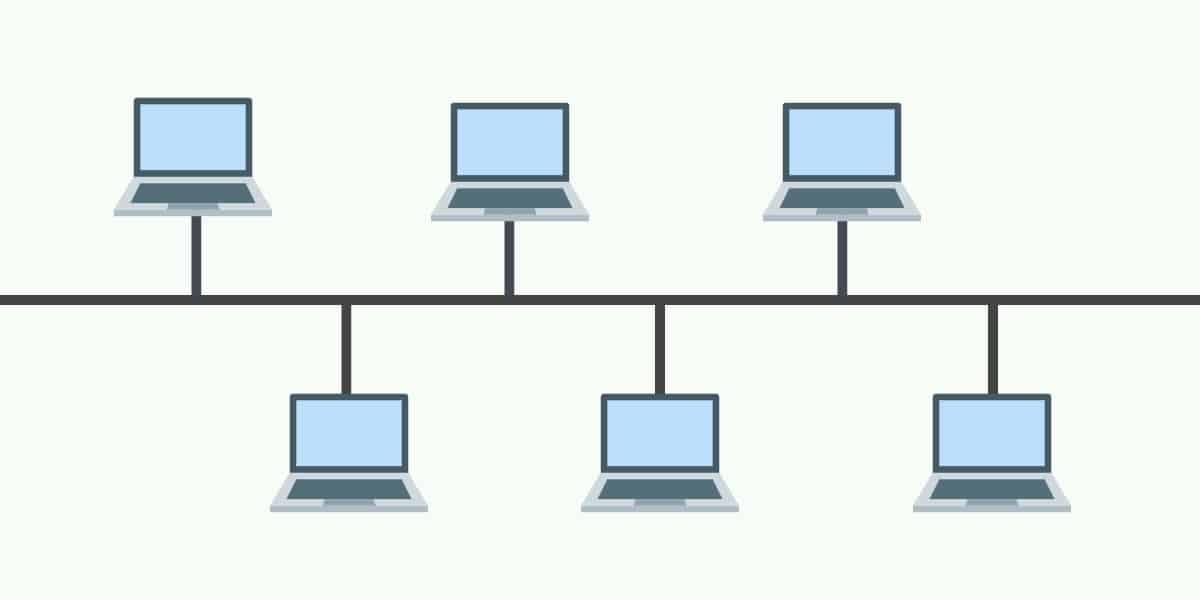Network Topology
 ShirishaKuruva
ShirishaKuruvaTopology:
Arrangement of nodes of a computer network is called topology.
→Topology can be viewed as physical and logical .
Physical Topology - Placement of various nodes.
Logical Topology - Deals with the data flow in the network.
Various Topologies:
Bus topology
Ring topology
Star topology
Mesh topology
Hybrid topology
1.Bus Topology
All devices are connected to a single central cable called the backbone.
Data travels in both directions along the cable, but only one device can send data at a time.
Requires less cabling, making it a cost-effective option, especially for small networks.
Simple to install and extend by adding new devices along the backbone cable.
If the main cable fails, the entire network is disrupted.

Advantages of Bus Topology:
Cost-effective: Requires less cabling, making it cheaper to set up.
Easy Installation: Simple to implement and extend by adding more devices along the central cable.
Less Cable Required: Compared to other topologies like star or mesh, bus topology uses less cabling.
Ideal for Small Networks: Works well for small-scale networks where traffic is minimal.
Disadvantages of Bus Topology:
Single Point of Failure: If the main cable (backbone) fails, the entire network goes down.
Limited Cable Length: The length of the central cable restricts how many devices can be connected.
Data Collisions: With more devices, the risk of data collisions increases, reducing efficiency.
Troubleshooting Difficulty: It can be hard to pinpoint faults when a failure occurs.
Ring topology
All devices are connected in a circular loop, where each device is connected to two others.
Data travels in one direction around the loop, passing through each device until it reaches its destination.
There is no need for a central hub or switch, as the devices themselves manage data transmission.
Adding or removing devices can disrupt the network temporarily.
If one device or connection fails, the entire network can go down unless there is a backup mechanism like a dual ring.

Advantages of Ring Topology:
Data Collisions Are Rare: Since data travels in one direction, collisions are minimized.
Equal Access: Each device has equal opportunity to transmit data, preventing traffic bottlenecks.
Consistent Performance: The fixed data path ensures steady performance, even with more devices.
Efficient for Light Traffic: Works well in networks with minimal traffic or data exchange.
No Need for a Central Hub: The design eliminates the need for a central network controller or hub.
Disadvantages of Ring Topology:
Single Point of Failure: If one device or connection fails, the entire network can be disrupted unless there’s a backup ring.
Difficult Troubleshooting: Identifying the failure point in the loop can be challenging.
Adding/Removing Devices Disrupts the Network: Any changes to the network require a temporary shutdown.
Not Scalable: Performance may degrade as the network size increases.
Star topology
All devices are connected to a central hub or switch.
Each device has its own connection to the central hub.
The hub controls all data traffic between devices.
If one device fails, it doesn't affect the rest of the network.
Easy to add or remove devices without disrupting the network.
The hub or switch can handle multiple data transfers at the same time.
If the central hub fails, the whole network goes down.

Advantages of Star Topology:
Easy to Install and Manage: The layout is simple, with each device directly connected to the central hub.
Centralized Management: The hub or switch manages all data transmission, making it easier to monitor and control.
Easy to Add/Remove Devices: Devices can be added or removed without disrupting the entire network.
High Performance: Data can be transmitted simultaneously between different pairs of devices, especially with a switch.
Disadvantages of Star Topology:
Single Point of Failure: If the central hub or switch fails, the entire network goes down.
Higher Cost: More cabling is needed compared to bus or ring topologies, and the hub or switch adds to the expense.
Limited by Hub Capacity: The number of devices that can be connected depends on the number of ports available in the hub or switch.
Dependent on Central Hub: The performance of the entire network depends on the efficiency of the hub or switch.
Mesh topology
Each device is connected to every other device in the network.
Provides multiple paths for data to travel between devices.
If one connection fails, data can still travel through other paths.
Very reliable since there's no single point of failure.
Direct communication between devices makes data transfer faster.
Requires a lot of cabling and hardware, making it expensive.
Setup and management are complicated due to many connections.
Advantages of Mesh Topology:
High Reliability: Multiple connections mean that if one link fails, data can be rerouted through another path.
No Single Point of Failure: Since every device is interconnected, the network remains operational even if a connection goes down.
Data Travels Quickly: Direct communication between devices allows for faster data transfer.
High Redundancy: Offers backup routes for data, making the network very robust and secure.
Disadvantages of Mesh Topology:
Complex Setup: Installing and managing a mesh network is complicated due to multiple connections.
High Cost: Requires a lot of cabling and network hardware, increasing the overall cost.
Difficult Maintenance: Troubleshooting and managing multiple connections can be challenging.
More Space Required: The network requires more physical space for all the connections and cables.
Hybrid topology
Combines two or more different topologies, like star and bus.
Flexible design allows for various network layouts and configurations.
Can scale easily by adding new devices and topologies.
Each section can operate independently, enhancing reliability.
Performance can be optimized based on specific needs of different parts.
More complex to design and manage due to multiple topologies.
Higher cost because it requires various types of equipment and cabling.

Advantages of Hybrid Topology:
Enhanced Reliability: If one part fails, the others can continue functioning.
Tailored Solutions: Organizations can implement the most effective topologies for their specific needs.
Improved Performance: Offers optimized performance by using the best features of various topologies.
Easier Maintenance: Issues can often be isolated to specific segments, making troubleshooting simpler.
Disadvantages of Hybrid Topology:
Complex Design: Creating a hybrid topology can be complicated due to the integration of different structures.
Higher Costs: Requires various types of equipment and cabling, leading to increased costs.
Challenging Management: Managing a network with multiple topologies can complicate network administration.
Potential Compatibility Issues: Different topologies may have compatibility issues that need to be addressed.
Subscribe to my newsletter
Read articles from ShirishaKuruva directly inside your inbox. Subscribe to the newsletter, and don't miss out.
Written by
